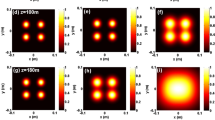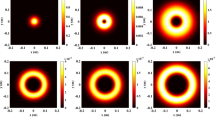Abstract
The study of Gaussian beam bidirectional transmission characteristics will help realize future space–air–ground–sea wireless optical link communication. This paper establishes a double-pass cross-media vertical transmission model of Gaussian beams in non-uniform seawater based on the Monte Carlo method. The distribution of photon emission scattering angle, the variation of photon number, the variation of photon energy, and the distribution of photon number are studied when Gaussian beams are transmitted up and down in the lower atmosphere–upper ocean link. The results show that with the increase of seawater depth, the total photon number and photon energy will gradually decrease, and the peak of the distribution function of the photon divergence angle moves to a large angle. As the chlorophyll concentration increases and the wind speed on the sea surface increases, the total photon number, and energy also decrease. The distribution of photon divergence angles also shifts to a large angle. When the Gaussian beam is transmitted in both directions, the number of photons received in the upstream transmission is smaller than that received in the downstream transmission if only the positions of the transmitting and receiving ends of the beam are exchanged. Our works will provide theoretical and technical support for the experiments of trans-media upstream and downstream transmission and communication of blue-green lasers in the lower atmosphere–upper ocean.











Similar content being viewed by others
Data availability statement
The datasets generated during and/or analyzed during the current study are available from the corresponding author on reasonable request.
References
S. Karp, Optical communications between underwater and above surface (satellite) terminals. IEEE Trans. Commun. 24(1), 66–81 (1976)
T. Wiener, S. Karp, The role of blue/green laser systems in strategic submarine communications. IEEE Trans. Commun. 28(9), 1602–1607 (1980)
B. Woodward, H. Sari, Underwater speech communications with a modulated laser. Appl. Phys. B 91, 189–194 (2008)
R. Dai, W. Gong, J. Xu et al., The edge technique as used in Brillouin lidar for remote sensing of the ocean. Appl Phys B 79, 245–248 (2004)
S.Q. Duntley, Light in the sea*. J. Opt. Soc. Am. 53(2), 214–233 (1963)
E. Tinet, S. Avrillier, J.M. Tualle, Fast semianalytical Monte Carlo simulation for time-resolved light propagation in turbid media. J. Opt. Soc. Am. A 13(9), 1903–1915 (1996)
Q. Xu, X. Zhao, Optical characteristics of laser beam passing through wind wave sea. Oceans Bull. 13(5), 6 (1994)
M. Wang, W. Liu, J. Wang, Analysis of signal energy transfer in blue-green laser uplink transmission channel. J. East China Shipbuild. Inst. (Nat. Sci. Ed.) 04, 38–41 (2003)
Z. Jin, T.P. Charlock, K. Rutledge et al., Analytical solution of radiative transfer in the coupled atmosphere-ocean system with a rough surface. Appl. Opt. 45(28), 7443–7455 (2006)
T. Zhou, W. Chen, Y. He et al., Beam spatial distribution of upward laser through sea-air interface. Chin. J. Lasers 37(8), 1978–1982 (2010)
W. Cox, J. Muth, Simulating channel losses in an underwater optical communication system. JOSA A, Optica Publishing Group 31(5), 920–934 (2014)
X. Qi, X. Han, Study of laser scattering characteristics of rough sea surface with foams. Acta Optica Sinica 35(8), 0829003 (2015)
X. Li, X. Miao, X. Qi et al., Laser atmosphere-seawater channel transmission characteristics under complicated sea conditions. Acta Optica Sinica 38(3), 0301002 (2018)
X. Li, X. Miao, X. Qi et al., Research on the propagation characteristics of blue-green laser through sea surface with foams. Optik 170, 265–271 (2018)
R. Sahoo, S.K. Sahu, P. Shanmugam, Estimation of the channel characteristics of a vertically downward optical wireless communication link in realistic oceanic waters. Opt. Laser Technol. 116, 144–154 (2019)
T. Li, Y. Yang, X. Gao, in Laser transmission model for a cross-medium uplink channel. 2020 IEEE 9th joint international information technology and artificial intelligence conference (ITAIC), 2020, p. 454–459
C. Li, R. Yuan, H. Gao et al., Characteristics of blue-green laser downlink cross-media transmission under different weather conditions. Acta Photonica Sinica 50(12), 34–48 (2022)
L. Dong, N. Li, X. Xie, C. Bao, X. Li, D. Li, A fast analysis method for blue-green laser transmission through the sea surface. Sensors 20(6), 1758 (2020)
M. Wang, Y. Wang, D. Chen et al., Transmission Characteristics of Blue-green Laser Through Two-Dimensional Dynamic Sea Surface-Bubble Layer[J]. Acta Optica Sinica 42(2), 0214001 (2022)
M. Wang, Q. Cheng, J. Li et al., Transmission characteristics of blue-green vortex beams in the lower atmosphere-upper ocean link. J. Quant. Spectrosc. Radiat. Transfer 286, 108205 (2022)
M. Al Naboulsi, Fog attenuation prediction for optical and infrared waves. Opt. Eng. 43(2), 319–329 (2004)
A. Bricaud, A. Morel, M. Babin et al., Variations of light absorption by suspended particles with chlorophyll a concentration in oceanic (case 1) waters: analysis and implications for bio-optical models. J. Geophys. Res. Oceans 103(C13), 31033–31044 (1998)
M. Lewis, J. Cullen, T. Platt, Phytoplankton and thermal structure in the upper ocean: consequences of nonuniformity in chlorophyll profile. J. Geophys. Res. Oceans 88(C4), 2565–2570 (1983)
C. Cox, W. Munk, Measurement of the roughness of the sea surface photographs of the sun’s glitter. J. Opt. Soc. Amer 44(11), 838–850 (1954)
Funding
This work was supported by the Training Program of the Major Research Plan of the National Natural Science Foundation of China (92052106); National Natural Science Foundation of China (61771385); Science Foundation for Distinguished Young Scholars of Shaanxi Province (2020JC-42); Science and Technology on Solid-State Laser Laboratory (6142404190301); and Science and technology research plan of Xi’an city (GXYD14.26).
Author information
Authors and Affiliations
Contributions
All the authors contributed to the study conception and design. Material preparation, data collection and analysis were performed by Jialin Zhang, Mingjun Wang, Qun Cheng and Yuhang Wang. The first draft of the manuscript was written by Jialin Zhang, and all the authors commented on previous versions of the manuscript. All the authors read and approved the final manuscript.
Corresponding author
Ethics declarations
Conflict of interest
The authors have no relevant financial or non-financial interests to disclose.
Additional information
Publisher's Note
Springer Nature remains neutral with regard to jurisdictional claims in published maps and institutional affiliations.
Rights and permissions
Springer Nature or its licensor (e.g. a society or other partner) holds exclusive rights to this article under a publishing agreement with the author(s) or other rightsholder(s); author self-archiving of the accepted manuscript version of this article is solely governed by the terms of such publishing agreement and applicable law.
About this article
Cite this article
Zhang, J., Wang, M., Cheng, Q. et al. Bidirectional transmission characteristics of Gaussian beams in the lower atmosphere–upper ocean link. Appl. Phys. B 129, 129 (2023). https://doi.org/10.1007/s00340-023-08072-1
Received:
Accepted:
Published:
DOI: https://doi.org/10.1007/s00340-023-08072-1




